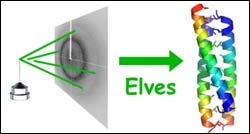Here you can find a summary of innovations in the fields of information and data processing and up-to-date developments on IT equipment and hardware.
This area covers topics such as IT services, IT architectures, IT management and telecommunications.

The convergence of information and communication technologies into a national “cyberinfrastructure” is poised to revolutionize the environmental sciences and many other disciplines in the coming years, according to researchers presenting at the AAAS Annual Meeting in Seattle. The two Feb. 13 sessions on cyberinfrastructure were organized by the heads of two National Science Foundation (NSF) directorates.
The speakers will describe a very near future in which computing capabilities will pr

Dartmouth researchers have developed an algorithm that might someday be used to analyze blood for diagnostic purposes. Using data from a mass spectrometer, a device that generates a molecular fingerprint of biological samples, the Dartmouth team’s calculations can distinguish healthy blood from diseased blood.
This study by Ryan Lilien, a Dartmouth M.D./Ph.D. student, Hany Farid, Assistant Professor of Computer Science , and Bruce Donald, the Foley Professor of Computer Science, appeare

Cornerstone to the W3C Speech Interface Framework is Nearly Complete
Giving voice to the Web, the World Wide Web Consortium (W3C) has published VoiceXML 2.0 as a W3C Proposed Recommendation. The goal of VoiceXML 2.0 is to bring the advantages of Web-based development and content delivery to interactive voice response applications.
Advancement of a W3C technical report to Proposed Recommendation indicates that the Working Group has successfully completed both public and W3C Wo

Determining the three-dimensional position of Mars Express in space with as much precision as possible, at a distance of 155 million kilometres away from Earth, is no simple business.
If the Solar System were shrunk down so that Earth was only the size of a soccer ball, then Mars Express would be a speck of dust floating well over two kilometres away!
ESA ground stations have kept track of the spacecraft’s range and velocity ever since launch.
By measuring the ‘Doppl

Scientists are finding a computer program called Elves to be a nearly magical solution to the tedious and time-consuming task of determining the 3-D shape of proteins – a major focus of cutting-edge proteomics today – from X-ray diffraction data.
According to Elves developer James Holton, who recently received his Ph.D. from the University of California, Berkeley, researchers can unleash Elves on a set of X-ray diffraction data and go on to other things – or take a nap – while the computer

Since most criminals only strike when they aren’t being watched, reliable surveillance of homes and businesses is a round-the-clock job. A University of Rhode Island researcher has made that job considerably easier and less expensive, thanks to a new technology he developed that can automatically track moving objects in real time.
Using low-cost, commercially available hardware, the Automatic Image Motion Seeking (AIMS) camera follows a moving object and keeps the target at the center of the